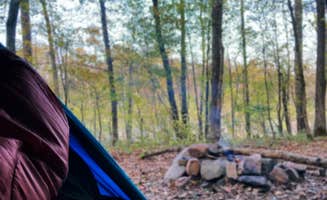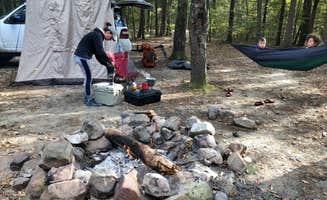Dispersed camping sites surround Gillham, Arkansas within the Ouachita National Forest, offering primitive overnight stays at elevations ranging from 600 to 2,600 feet. The forest terrain consists predominantly of oak and hickory trees with pine stands in higher elevations. Seasonal streams create natural boundaries between many camping areas, with most sites accessible via unpaved forest roads that often become difficult to navigate after rainfall.
What to do
Hiking access: The Ouachita National Forest features multiple trailheads near dispersed camping areas. Talimena Scenic Drive provides access to sections of the 223-mile Ouachita Trail with camping opportunities nearby. "This is an awesome place the drive is well worth it too as long as you don't catch fog like we did you couldn't see 2ft in front of your car," notes a camper at Talimena Scenic Drive.
Stream exploration: Cedar Creek offers natural swimming opportunities near several camping spots. A camper at Quachita NF Dispersed by Cedar Creek off 51220 shared: "Right off of Forest road 51220, large area to park and camp all by yourself. Stream is 40 feet away with a swimming hole. Very private."
Wildlife observation: The forest supports diverse wildlife including white-tailed deer, wild turkey, and various bird species. Morning and evening hours provide optimal viewing times from campsites. Pack binoculars and reference guides for species identification.
What campers like
Natural water features: The confluence of streams and rivers creates popular gathering spots. A reviewer camping at Pigeon Creek noted: "The river and creek merging was so beautiful! It was a beautiful drive there." Water levels fluctuate seasonally, with spring typically offering the strongest flows.
Seclusion factor: Many dispersed sites in the Ouachita Forest provide significant distance between camping areas. "You're in the middle of nowhere and it's gorgeous!" reports a camper staying at Blue Knob Road in Ouachita National Forest. Sites along forest roads typically offer greater separation than those near trailheads.
Rock fire rings: Established camping spots often feature stone fire rings from previous visitors. At Turner Creek Road, a camper mentioned: "Very secluded spot no amenities just a rock fire ring. Very peaceful." Always check current fire restrictions before using these rings.
What you should know
Road conditions: Forest access roads require careful navigation with potential for washouts. A camper at County Road D1590 stated: "Took our class c down the narrow road. Pretty good mostly rock. Camp site was clean." Seasonal rain can significantly alter road conditions.
Navigation challenges: Some sites prove difficult to locate without precise coordinates. One camper reported: "Could not find. The grid coordinates lead to someones private cabin. Tucked in middles of residential cabin community." Local ranger stations can provide updated information about site accessibility.
Campsite variation: Sites differ significantly in size, sun exposure, and terrain features. A camper at National Forest CR 51220 observed: "Many camps here some small some large. Some full sun some full shade! Most camp spots you have your own driveway and large spot. Adjacent spots probably a mile apart."
Tips for camping with families
Site selection: Choose camping locations near shallow water features for natural play spaces. Look for level ground with minimal undergrowth for tent placement and activities.
Wildlife precautions: Store food properly in sealed containers, preferably in vehicles. The Ouachita region has black bears, though sightings near campsites remain uncommon.
Navigation markers: The lack of designated site markers can make returning to camp challenging. One camper at Mena Arkansas described their experience as a "Good secluded spot for Privacy." Consider marking your route with temporary trail markers when exploring with children.
Tips from RVers
Vehicle limitations: Most rustic camping near Gillham suits smaller RVs with high clearance. A camper with a 30-foot Class C noted: "I have a 30ft Class C which is probably the largest vehicle you would want to drive down the dirt road to this site."
Backing techniques: Limited turning space requires backing skills at several sites. An experienced driver advised: "I have a CDL and back stuff all day. Don't try to pull in. Back in off the Buck Mountain."
Isolation considerations: Remote locations mean limited assistance if mechanical issues arise. One RVer reported: "Definitely isolated, kind of creepy at night. Drove our 29ft class c to the site, road is mostly small rocks." Carry basic repair supplies and emergency communication equipment.



